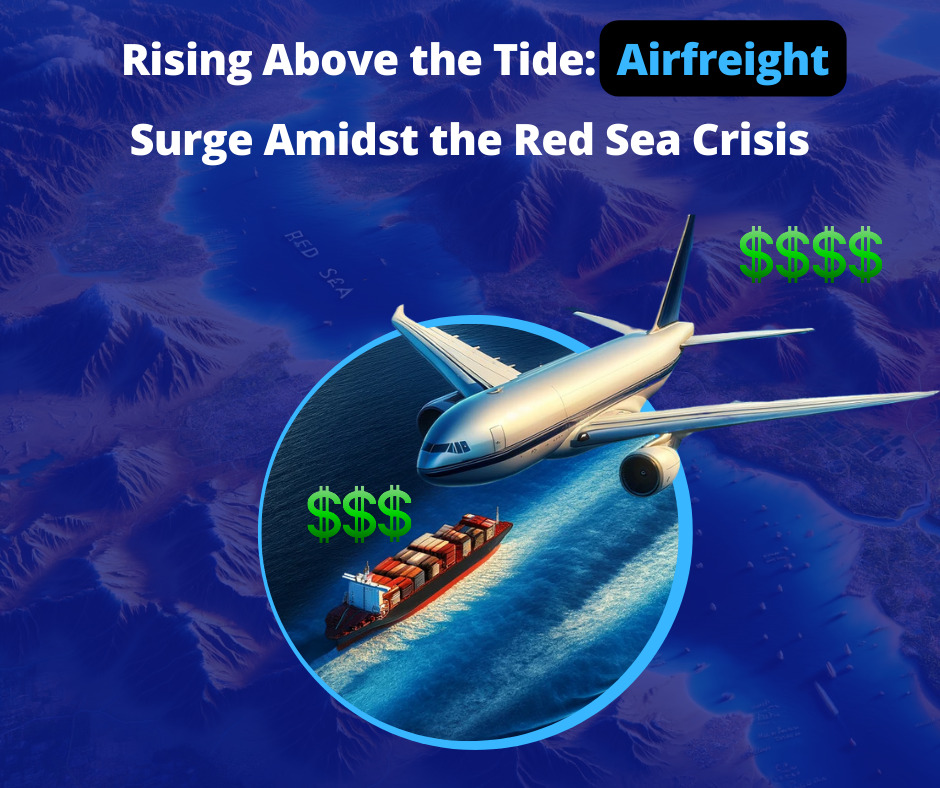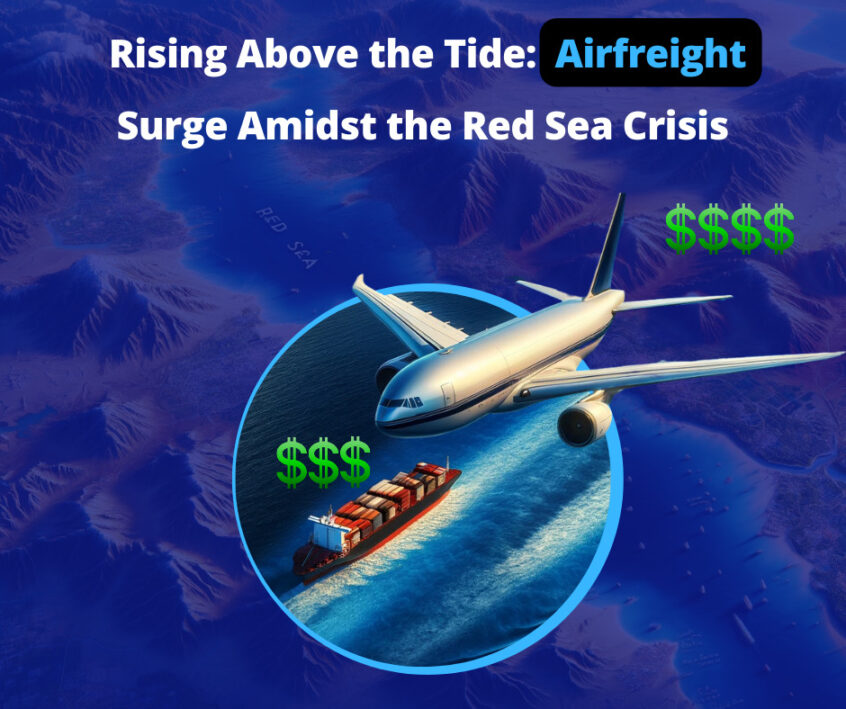
The Impact of the Red Sea Crisis on Air and Ocean Freight
The recent crisis in the Red Sea, a critical maritime route, has sent ripples through the logistics industry, reshaping global freight dynamics. As tensions escalate, a significant shift is observed in the transportation of goods. It particularly affects ocean shipping routes and airfreight volumes. This article examines the multifaceted implications of the Red Sea conflict for the logistics sector, focusing on the gradual yet noticeable increase in airfreight, the stability of ocean shipping through the Suez Canal despite challenges, and the strategic adjustments by key industry players.
Background of the Red Sea Crisis
The Red Sea—a critical maritime route connecting the Mediterranean Sea to the Indian Ocean via the Suez Canal—has historically been a nexus for international trade and geopolitics. The sea’s recent crisis can be attributed to a complex interplay of regional conflicts, political tensions, and strategic control over key maritime routes.
The Geopolitical Importance of the Red Sea
- Strategic Maritime Route: The Red Sea is one of the world’s most important sea lanes. The Suez Canal’s northern end is a vital transit point for global shipping. It handles about 10% of international maritime trade and serves as the shortest sea link between Asia and Europe, making it a crucial economic artery.
- Regional Powers and Interests: Surrounding the Red Sea are countries with varying political and economic interests. These include Egypt, Saudi Arabia, Yemen, Sudan, Eritrea, and more. The region’s strategic importance has made it a focal point for regional powers vying for control and influence.
The Yemen Conflict and Its Impact
- The Houthi Insurgency: The ongoing conflict in Yemen has significantly impacted the crisis. The Houthi rebel movement, aligned with Iran, has been engaged in a protracted conflict with the Yemeni government, supported by a Saudi-led coalition. This conflict then spilled over into the maritime domain.
- Attacks on Shipping Lanes: The Houthis have intermittently targeted commercial shipping in the Red Sea, particularly around the Bab el-Mandeb Strait, a narrow passage crucial for global shipping. These attacks have included the use of sea mines, boat-borne improvised explosive devices, and missile strikes.
Economic Implications
- Threat to Global Shipping: Any disruption in the Red Sea impacts the Suez Canal and, consequently, global trade. This region’s instability may cause significant delays in shipping routes, leading to increased costs and logistical challenges.
- Impact on Oil Prices: The Red Sea is a major route for oil shipments from the Middle East to Europe and North America. Instability in the region can lead to fluctuations in oil prices, impacting global markets.
International Responses
- Naval Presence and Security Measures: In response to the increasing threats, several countries, including members of the European Union, the United States, and regional actors, have deployed naval forces to secure the shipping lanes and protect commercial vessels.
- Diplomatic Efforts: There have been various diplomatic efforts to resolve the conflict in Yemen, recognizing that a political solution is essential for long-term stability in the region. These measures, however, have faced significant challenges.
Current Status and Future Outlook
The situation in the Red Sea remains tense, with sporadic incidents of aggression disrupting maritime activities. Given the global economic implications of any major disruption in this vital maritime corridor, the international community continues to monitor the situation closely.
As of early 2024, the Red Sea crisis continues to impact global maritime logistics significantly. The Suez Canal, a critical juncture in this region, facilitates about 12% of global trade, with approximately 19,000 ships passing through annually, according to the Suez Canal Authority. In the wake of the crisis, there has been a notable uptick in maritime security incidents.
Reports from the International Maritime Bureau indicate a 30% increase in piracy and armed robbery incidents in the Red Sea region compared to the previous year. The conflict in Yemen, a critical factor in the crisis, has led to numerous attacks on shipping lanes, with the European Union Naval Force reporting over 20 incidents of maritime aggression in the vicinity of the Bab el-Mandeb Strait within the last six months.
These incidents have caused considerable disruption, with shipping companies rerouting approximately 15% of their vessels, adding to transit times and costs. This rerouting typically involves a detour around the Cape of Good Hope, increasing journey lengths by an average of 3,500 nautical miles, per Lloyd’s List Intelligence. As a result, shipping delays have increased by an average of 8-10 days for affected routes.
In response, airfreight has seen a moderate increase in demand, with volumes rising by about 5% since the onset of the crisis. This is indicated by data from the International Air Transport Association (IATA). The shift has led to a corresponding rise in air cargo rates, which have increased by approximately 12% on key routes from Asia to Europe and North America, according to the TAC Index. The ongoing situation underscores the fragility of global maritime logistics and the far-reaching consequences of regional conflicts on international trade.
The Red Sea crisis is a multi-dimensional issue with deep-rooted geopolitical, economic, and security implications. It underscores the delicate balance of interests in one of the world’s most strategically significant regions and the critical need for stability to ensure the uninterrupted flow of global trade.
The Shift to Airfreight
As the conflict persists, logistics experts anticipate a steady rise in airfreight demand. Although the initial response has been moderate, companies like Scan Global Logistics report a noticeable uptick in air cargo volumes. This increase is attributed to the prolonged nature of the Red Sea disruption, prompting businesses to seek alternative, faster shipping routes.
Rate Dynamics and Capacity Adjustments
Traditionally more volatile than ocean shipping, airfreight rates are expected to face upward pressure. With the Lunar New Year period typically seeing a surge in cargo movements, the combined effect of the holiday rush and the Red Sea conflict could further strain airfreight capacity. Forwarders like DB Schenker proactively secure additional airfreight space to accommodate this shift from ocean to air transport.
Ocean Freight’s Resilience Amidst Crisis
Despite the turmoil in the Red Sea region, the Suez Canal Authority has maintained that navigation through this crucial artery remains unaffected. This stability is vital, considering the canal’s role in facilitating approximately 10% of global maritime trade. However, some major container carriers continue to reroute their operations, opting for longer but safer paths, such as the Cape of Good Hope, to circumvent the risks associated with the Red Sea passage.
Impact on Shipping Schedules and Costs
While ensuring safety, these diversions introduce delays and additional fuel costs, impacting the overall efficiency of ocean freight. Shipping companies are thus faced with balancing safety, timeliness, and cost-effectiveness in their routing decisions.
Strategic Responses from Industry Players
- Preparing for Shifts in Freight Dynamics: Companies across the logistics spectrum are bracing for the changes induced by the Red Sea situation. While some, like FedEx, report minimal shifts towards airfreight, others are actively preparing for a potential surge in demand. The contrasting responses highlight the varying levels of impact on different sectors within the industry.
- Balancing Sea-Air Solutions: In light of the current scenario, a combination of sea and air transport emerges as a pragmatic solution for many. Companies can mitigate the cost impact by utilizing ocean shipping for part of the journey and airfreight for time-sensitive segments while maintaining schedule integrity.
- Rerouting and its Consequences: The decision by several shipping companies to reroute via the Cape of Good Hope, though necessary, is not without consequences. This longer journey extends transit times and increases fuel consumption, contributing to higher operational costs and environmental impact.
- Geopolitical Influences on Logistics: The Red Sea crisis underscores how geopolitical factors can significantly influence logistics strategies. The recent air strikes by the US and UK in Yemen, aimed at deterring attacks on shipping, reflect the complex interplay of international relations and trade logistics.
Wrapping Up
The Red Sea conflict presents a challenging landscape for the logistics industry, prompting a strategic recalibration of air and ocean freight operations. While airfreight experiences a gradual increase in demand, ocean shipping through the Suez Canal remains resilient, albeit with necessary adjustments. The situation highlights the need for agility and adaptability in the logistics sector, underlining the importance of balancing efficiency, cost, and safety in the face of geopolitical uncertainties. The lessons learned will undoubtedly contribute to a more resilient and responsive global supply chain as the industry navigates these turbulent waters.


